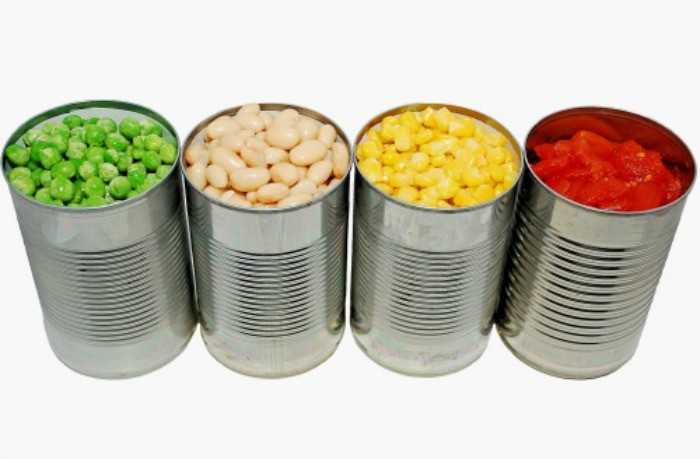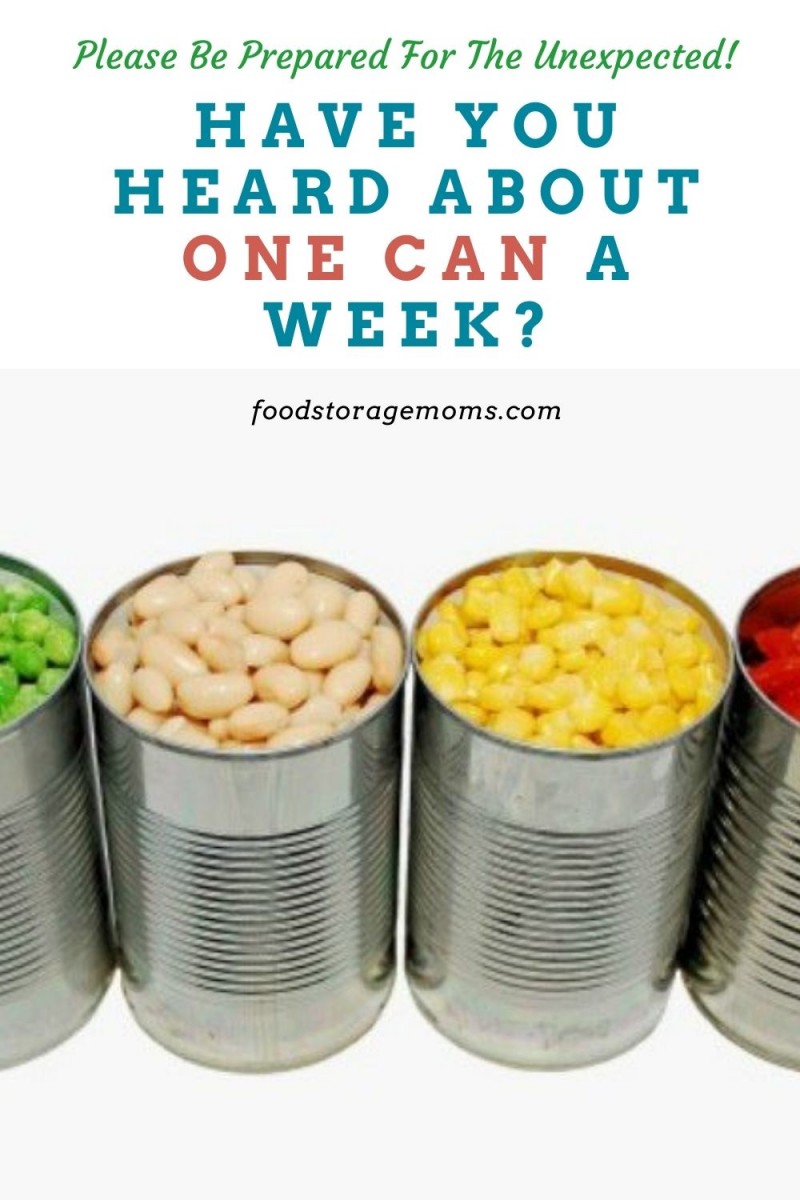
As a person who feels the need to be prepared for emergencies of all kinds, and to also help others in their preparation efforts, one can at a time has been my motto for many years. Have you heard about one can a week? Sometimes people get overwhelmed when they start a food storage plan. I’ve been wanting to update this post so I can assist those who may be getting started in their emergency preparation journey.
Let’s make this really easy and plan to get one can a week each time we go shopping. It can be a #10 can of dehydrated or freeze-dried meat, vegetables, fruit, wheat, rice, etc. I will explain the difference between dehydrated and freeze-dried below.
You can also buy one can of beans, chili, fruit cocktail, peas, or any other fruit or veggie each week when you go to the grocery store. It’s one extra can you didn’t have yesterday. Once you get a significant inventory, be sure to rotate what you buy and eat what you store.
Have You Heard About One Can A Week?

Closed Grocery Stores
I hope people realize that if we have a major disaster our local grocery stores may be empty within a matter of hours. You may not be able to even drive to any stores if there is a significant disaster that wipes out roads or bridges in your area. Our local government officials may ask us to stay off the roads because of ice, heavy snow, or the roads are washed away from a flood.
There could be one of many possible reasons we must have food stored in our homes. Water is first and foremost when it comes to storage concerns, but today we are talking about canned food.
Water Needed
In case you don’t know, the water needed per person per day, according to The American Red Cross, states one gallon. I prefer 4-gallons per person per day. But that’s how I roll. We need water for hydration, hygiene, cooking, cleaning, and spit baths. Yes, I have baby wipes I could use in a pinch, and if they dry out I can add some water, they will still work for small personal cleanups.
As we discuss food storage, always remember that many foods require some water to make them usable. That especially goes for any dehydrated foods on your shelves. You’ll want to “reconstitute” them by adding some water so they take on as much of their former shape and texture as possible. Even a can of soup generally requires a can of water for it to have the consistency you’ll want when it comes to serving it.
One Can Of Food
My favorite food storage products for the long term are freeze-dried items because they have a longer shelf life if stored in optimal conditions. That means you don’t want them stored in your hot garage.
Every brand is different when it comes to estimated shelf life, so check the brands available and then you can decide to purchase the ones you feel have the best price per ounce and the longest shelf life. Be sure to check the labels so you can see when it was packed and the estimated shelf life for that particular product. Don’t plan on all the products from the same manufacturer having an identical shelf life, they will vary. Freeze-Dried Foods by Linda
Freeze-Dried Food Storage
Pros: Freeze-dried lasts longer.
Pros: You can eat most freeze-dried fruits and vegetables right out of the can.
Pros: Freeze-dried foods tend to taste better.
Cons: Freeze-dried products are more expensive. They have also shown significant increases over the past few months.
Dehydrated Food Storage
Dehydrated food has been around for years. Dehydrated food does not store as long as freeze-dried, but who cares if you are going to use it within 5-8 years. As with freeze-dried foods, the various products will have a different shelf life. I buy dehydrated potato slices, they are awesome! Dehydrated Foods by Linda
Pros: Dehydrated food is cheaper in price compared to freeze-dried.
Pros: There is a wide variety of dehydrated foods.
Cons: To make it the most flavorful and with the desired textures, generally dehydrated food must be cooked using your stored water or it will not be edible. You also need to think about fuel to cook it if the power is out and you don’t have a workable stove.
One Case At A Time
We’ve been talking about building up your storage inventory by buying one can at a time. If it fits your budget and you have adequate space, consider buying your canned goods by the case. Most grocery stores will have case lot sales at least once a year. It seems they often have these sales in the fall of the year.
I may have told you this story before about a woman I know who buys several cases of food at case lot sales with the plan that she’ll eat from those cases for as long as a year if a disaster hits her neighborhood. She is a single elderly woman who knows the need to be prepared. She prefers fresh food, but realizes that fresh foods may not be available when disasters strike.
Before the end of the year, and before the food expires, she donates all of it to the food bank and then starts over. If that doesn’t give you chills I don’t know what would. She is amazing, I LOVE her preparedness and giving attitude.
52 Weeks: One Can At A Time
These cans can be dehydrated, freeze-dried, or cans of food down any grocery aisle that has food you and your family will eat. Of course, we still need the basics to bake bread, tortillas, biscuits, crackers, etc. Today it’s all about one can at a time. Note that with some items on the list you typically buy them in a package rather than a can, but the idea is the same:
- Beans
- Chili
- Spaghettios
- Soup
- Stews
- Corn
- Green beans
- Peas
- Beets
- Apple slices
- Instant milk
- Butter, Red Feather is my favorite Red Feather Butter
- Canned Bacon Yoders Bacon
- Peaches
- Applesauce
- Mac and Cheese
- White Rice (bags)
- Salsa
- Ravioli’s
- Pasta (packages)
- Crackers
- Mayo
- Mustard
- Miracle Whip
- Cans of tuna
- Cans of cooked hamburger
- Cans of cooked chicken
- Cans of roast beef
- Cans of chipped beef Linda’s Chipped Beef Recipe
- Freeze-dried cheeses (there are so many to choose from at Thrive Life)
- Cream of chicken soup (my favorite)
- Chicken broth
- Sweet potatoes
- White potatoes
- Broccoli
- Spinach
- Olives
- Spaghetti sauce
- Tomato sauce
- Zucchini
- Asparagus
- Chocolate
- Peanut butter
- Jam or jelly
- Green chili sauce
- Cauliflower
- Celery
- Carrots
- Tomatoes
- Freeze-dried chicken
- Freeze-dried beef
- Hardtack candy
One critical aspect of food storage is to be sure and buy what your family will eat. Some family members tend to be picky eaters, so consider their needs. Also, you may have members with food allergies or special diet needs, those issues need to be taken into account. All you need to do is write down what your family typically eats each day, then buy accordingly. My printable worksheet may help you. Where Do I Start by Linda You can fill in the areas with ideas for breakfast, lunch, and dinner. It has a place on the side to put down the food items you want to purchase.
I had a reader mention on Facebook that only the rich and wealthy can afford freeze-dried or dehydrated food. I am not wealthy by any means. I buy a case of six cans once every quarter. I have been doing this for years. You may know people who have purchased pallets of food delivered to their homes. I’m not one of those.
Update: as of today with the prices of freeze-dried food, I have stopped buying #10 cans. They are way too expensive right now.
I put everything in alphabetical order so I can see at a glance what I have on hand. Then I can see the areas where I need to add one can or more to the shelf.
Why is it important for me to have food and water stored?
I have some readers who will indicate they don’t fully understand why I’m so passionate about preparedness, and particularly food and water. We often think our storage will come in handy only if we have a major disaster or emergency situation. Please remember that life events can come in many shapes, sizes, and frequencies.
Do you know anyone or a family experiencing job loss, health challenges, recent car or in-home accidents, loss of the breadwinner, etc.? Lately, it seems we’ve been aware of people affected by all the above challenging incidents. No one expects these things to occur, but if you’ve planned ahead “just in case,” you’ll be so much better off than your neighbor who didn’t.
Final Word
Thanks again for being prepared for the unexpected. Please be ready for emergencies or disasters that may come your way. If someone asks you, “have you heard about one can at a time,” you can answer that you have and that you’re also following through and building up your food storage inventory. Throw in an extra case of water in your grocery basket from time to time, you’ll need that when it comes to putting your dehydrated food to use. You’ll be glad you don’t have to stand in line to get water if your water is contaminated in your neighborhood. May God Bless this world, Linda
My book would be a great asset: Prepare Your Family For Survival by Linda Loosli
Copyright Picture: AdobeStock_103207687 by Julie Clopper
The post Have You Heard About One Can A Week? appeared first on Food Storage Moms.

Leave a comment